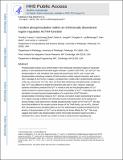Tandem phosphorylation within an intrinsically disordered region regulates ACTN4 function
Author(s)
Travers, Timothy; Shao, Hanshuang; Wells, Alan; Camacho, Carlos J.; Joughin, Brian Alan; Lauffenburger, Douglas A; ... Show more Show less
DownloadLauffenburger_Tandem phosphorylation.pdf (2.065Mb)
OPEN_ACCESS_POLICY
Open Access Policy
Creative Commons Attribution-Noncommercial-Share Alike
Terms of use
Metadata
Show full item recordAbstract
Phosphorylated residues occur preferentially in the intrinsically disordered regions of eukaryotic proteins. In the disordered amino-terminal region of human a-actinin-4 (ACTN4), Tyr[superscript 4] and Tyr[superscript 31] are phosphorylated in cells stimulated with epidermal growth factor (EGF), and a mutant with phosphorylation-mimicking mutations of both tyrosines exhibits reduced interaction with actin in vitro. Cleavage of ACTN4 by m-calpain, a protease that in motile cells is predominantly activated at the rear, removes the Tyr[superscript 4] site. We found that introducing a phosphomimetic mutation at only Tyr[superscript 31] was sufficient to inhibit the interaction with actin in vitro. However, molecular dynamics simulations predicted that Tyr[superscript 31] is mostly buried and that phosphorylation of Tyr[superscript 4] would increase the solvent exposure and thus kinase accessibility of Tyr[superscript 31]. In fibroblast cells, EGF stimulation increased tyrosine phosphorylation of a mutant form of ACTN4 with a phosphorylation-mimicking residue at Tyr[superscript 4], whereas a truncated mutant representing the product of m-calpain cleavage exhibited EGF-stimulated tyrosine phosphorylation at a background amount similar to that observed for a double phosphomimetic mutant of Tyr[superscript 4] and Tyr[superscript 31]. We also found that inhibition of the receptor tyrosine kinases of the TAM family, such as AXL, blocked EGF-stimulated tyrosine phosphorylation of ACTN4. Mathematical modeling predicted that the kinetics of phosphorylation at Tyr[superscript 31] can be dictated by the kinase affinity for Tyr[superscript 4]. This study suggests that tandem-site phosphorylation within intrinsically disordered regions provides a mechanism for a site to function as a switch to reveal a nearby function-regulating site.
Date issued
2015-05Department
Massachusetts Institute of Technology. Department of Biological Engineering; Koch Institute for Integrative Cancer Research at MITJournal
Science Signaling
Publisher
American Association for the Advancement of Science (AAAS)
Citation
Travers, T., H. Shao, B. A. Joughin, D. A. Lauffenburger, A. Wells, and C. J. Camacho. “Tandem Phosphorylation Within an Intrinsically Disordered Region Regulates ACTN4 Function.” Science Signaling 8, no. 378 (May 26, 2015): ra51–ra51.
Version: Author's final manuscript
ISSN
1945-0877
1937-9145